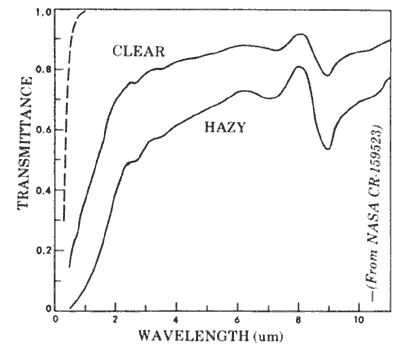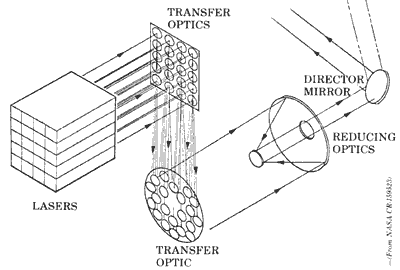by Ray Sperber
From L5 News, June 1980
By now most readers of the L-5 News are probably quite familiar with the concept of Solar Power Satellites (SPS). These collect solar energy in space and beam it to earth as microwaves which are then received and converted to electricity for use in the electrical power grid. The use of lasers as an alternate, perhaps more attractive, means of beaming down power from the satellites has been investigated by a number of researchers. One concludes that “. . . the capabilities of the proposed laser power beaming systems considerably exceed those of the microwave SPS systems that have been extensively studied by NASA” [1] but the more common conclusion [2-5] is that the use of lasers is not as attractive as beaming power by microwaves because of relatively low laser efficiencies to date. Almost all the findings are such that the laser option should continue to receive attention as an alternative to microwave power transmission.
The first question that may pop into the reader’s mind is, “Aren’t lasers dangerous? Couldn’t you zap people on the ground from space?” The answer is, “Yes, you could, but you don’t have to have dangerously intense beams to provide a useful power transmission system.” It appears that intensities of no more than five suns would provide workable power links without appreciable economic penalty. Furthermore, peaceful intent on the part of the user can be monitored from the ground by watching the power transmitting station’s output mirror size. This effectively determines the focus — how high
an intensity the beam can have. An international convention limiting maximum allowable aperture areas of lasers in space appears to be a workable way to prevent weapons use. [With precise remote control it might still be possible to phase lock and coherently transmit from several smaller apertures to produce a high intensity region on the ground. Again, this could be monitored by checking the type of hardware installed in space. The necessarily very much more complex remotely coherently controllable hardware could be easily spotted and dealt with.]
The technical aspects of safe, controllable and efficient power beaming are more complex with lasers than with microwaves. This is because with lasers the transmission distance in wavelengths is four orders of magnitude longer and there is a wider and more rapidly varying range of atmospheric phenomena that may interfere with the beam. Nevertheless, it is felt that it should be possible to get the typical 50 MW power beam down to one of three or four receivers scattered over 100 km over 97% of the time. These would be high altitude sites in the southern US, roughly 100 meters in distance, for which transmittances are anticipated to be greater than 58% near 5 microns of wavelength and greater than 90% near 10 microns.
For purposes of illustration, let us consider the design of a laser power satellite system. The first step in the design procedure is to take a chart like that in Figure 1 for the target sites, pick operational wavelength(s) and then calculate probabilities of clear weather using weather charts. Typically the wavelengths chosen are in atmospheric transmission “windows” in the 5 to 10 micron range. The strongest absorbers tend to be water in all forms and carbon dioxide. Thus one tries to look for “water holes” and beam to dry sites at higher altitudes.

Figure 1. Transmittance for a vertical line-of-sight through the entire atmosphere; dashed curve: Rayleigh scattering; solid curves, aerosol.
The next step is to characterize the laser desired. A problem here is that, although many types of lasers exist and even more have been proposed, they are almost all notoriously inefficient in terms of light output per unit input power compared to microwave tubes, which have DC-microwave efficiencies above 80%. (In the laser business, an “efficient” laser is one which is over one percent efficient.) The field of laser options is thus quickly reduced to less than half a dozen. Probably the three most attractive of these are the free electron laser, electric discharge lasers and indirectly optically pumped lasers. The former two options are powered by electricity from photovoltaic solar arrays and the last one uses radiant heat from a solar heated black body cavity.
The free electron laser is a very recent, relatively unknown scientific development with potential efficiencies above 50% (DC-light). Electric discharge lasers, with DC-light efficiencies of around 30% are the most efficient lasers actually being constructed today. (The other two laser types mentioned here have not been constructed in the projected manner or operated at the projected efficiencies.) In indirectly optically pumped lasers projected solar-laser light efficiencies range up to 25% with rather conventional gas cycles.
Because the laser wavelengths are four orders of magnitude shorter than microwave wavelengths the aperture areas involved are a factor of 100 smaller. This allows a reduction in satellite power to around 50 MW and subkilometer satellite dimensions.
Except for the free electron laser all of the lasers above will require the coherent combining of multiple smaller laser beams into a single large aperture-transmitted beam as in Figure 2. While this combining is more sophisticated than present optical practice it appears to be attainable without undue difficulty.

Figure 2. Typical Laser SPS Transmitting Optics
Photovoltaics, thermal engines and optical rectenna diodes are candidates for the power receivers on earth in the laser SPS system design. While photovoltaic energy conversion of a laser beam will be more efficient than the conversion of sunlight, the basic physics of room temperature photovoltaics limit attainable efficiencies to around 40%. Cooling the receptors would improve this but requires unattractive refrigeration powers. Thermal engine power receivers much like the ground-based power tower installations now being constructed in the southwest are expected to have reception efficiencies around 60%. In fact, the existing solar power towers could be used by just repointing the already steerable reflectors. Finally, one might take advantage of modern electronic lithography to fabricate optical receiving dipole/diode elements directly analogous to microwave rectenna elements. Efficient operation requires incident laser intensities high enough (almost one gW/ square meter!) to overcome forward voltage drops in the rectifying diodes. However, since a nominal factor of ten of concentration can be easily used, and since all the laser concepts considered in this article can be pulsed (and all but the indirectly pumped laser must be pulsed) the desired peak fields can be obtained without exceeding average thermal limits. Light-electric efficiencies above 90% are felt to be attainable.
Comparing the best efficiencies projected for laser SPS system components with those of a microwave system shows that the best laser systems will provide about half as much electric power on earth per unit of intercepted sunlight. This necessarily impacts cost of power adversely by roughly that factor. The spatial diversity of the receivers also raises important operational issues. An exact scenario for where to beam when and how this affects power grid functions has yet to be developed although it is considered eminently feasible. Still, there may be situations where the smaller blocks of power that the laser systems can provide onto smaller receivers are useful. Laser powered airplanes are an example of this. Also, from a development item standpoint, the lower launch mass and maybe lower system development cost are not unattractive.
References
1. Rather, J.D.G. “New Candidate Lasers for Power Beaming and Discussion of their Applications,” from K. Billman. “Radiation Energy Con¬version in Space,” Progress in Aeronautics and Astronautics, Vol. 61. Cambridge, Massachusetts: MIT Press. 1978. PP. 313-332.
2. Jones, et al. “Final Report — Laser Power Conversion System Analysis,” Vols. I and 11. NASA CR-159523, March 15, 1979.
3. Beverly II, R.E. “Laser-SPS Systems Analysis and Environmental Impact Assessment.” R.E. Beverly III, Consulting Physicist, 1891 Fishinger Road, Columbus, Ohio, 1979.
4. Walbridge, E.W. “Laser Satellite Power Systems.” Argonne, Illinois: Argonne National Laboratory, January 1980.
5. Boeing Aerospace Company. “SPS System Definition Study, Laser SPS Analysis, Final Report for Phase III,” Vol. 3. Document #D180- 25969-3, Dec. 1979-May 1980.
Ray Sperber works at Boeing Aerospace Company’s Kent, Washington, facility.







